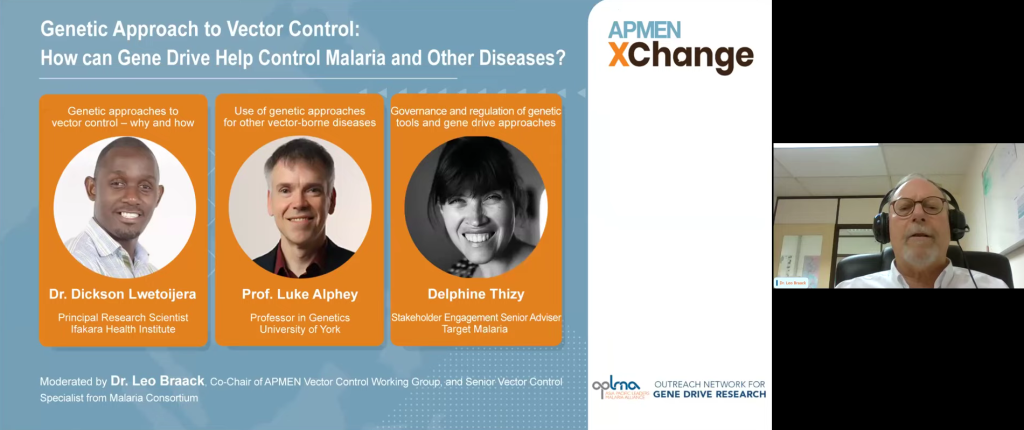This piece was written for Outreach Network for Gene Drive Research and republished here, authored by Leo Braack, Co-Chair of APMEN Vector Control Working Group; Senior Vector Control Specialist from Malaria Consortium
After many thousands of years of unabated onslaught by malaria decimating human populations across the world, convinced that the fevers originated from bad air associated with swamplands, Ronald Ross made the momentous discovery in 1897 that it was mosquitoes that transmitted this most unforgiving and rapidly deadly of afflictions. Since that year, humanity has relied on vector control as the most effective strategy to reduce the intensity of transmission and disease.
At first, we relied on control of larvae and breeding sites, then in the mid-19th century we sprayed massive amounts of the insecticide DDT and made considerable advances in tamping down malaria, at least until mosquitoes developed resistance to the chemical. By the 1990’s we had found new optimism to think we might just be able to control malaria, which by 2007 developed into full-blown ambitions to eradicate the disease, our hopes pinned on pyrethroid-impregnated bednets. But then, once again insecticide resistance by the mosquitoes, combined as always with other factors, humbled us to recognise that for every tool we came up with, nature had a workaround.
But humanity too is learning and advancing. From crude but effective initial efforts to drain swamps and ditches and pour oil on breeding sites, then to more sophisticated chemical warfare using DDT that resulted in eliminating malaria from America, much of Europe, and elsewhere, and then to insecticide-impregnated bednets that have saved millions upon millions of lives, we have entered yet another new era of innovation to fight not just malaria, but other mosquito-borne diseases. For World Mosquito Day, I had the privilege of facilitating an expert panel during a webinar on genetic approaches for vector control, co-organised by the Asia Pacific Leaders Malaria Alliance (APLMA), the Asia Pacific Malaria Elimination Network (APMEN) and the Outreach Network for Gene Drive Research.

The presentation session featured experts from various backgrounds. Dr Dickson Lwetoijera of the Ifakara Health Institute, Tanzania, kicked off the discussion and delved into the reasons for increased interest in genetic approaches for vector control, in particular gene drive for malaria control. He also emphasised the importance of establishing the right infrastructure, capacity-building initiatives and meaningful stakeholder engagement. Professor Luke Alphey from University of York, UK, then discussed the advantageous features of genetic methods to tackle other vector-borne diseases such as dengue. In this case, gene drive tools could be cost-effective, and attain hard-to-reach populations as in the case of malaria. He also described the advantages and disadvantages of the different genetic approaches currently in use and under investigation. Delphine Thizy from Target Malaria, focused her presentation on the existing frameworks to regulate gene drive approaches like the Cartagena Protocol on Biosafety, as well as the current international policy debate surrounding these tools.
The interest in the development of gene drives surged with the discovery of CRISPR-Cas9, the genetic editing technique spearheading a revolution in disease control. CRISPR-Cas9 is a useful tool that enables molecular biologists to snip genes that enables them to modify, for example, the ability of insect pests to do harm. And yes, the technology still raises concerns and remains a matter of debate. However, the potential applications will, if proven effective and safe, be limited to very specific and limited situations that have been exhaustively investigated and have been part of an informed debate with relevant stakeholders.
There is currently advanced research taking place that will enable scientists to impact malaria, dengue and other disease-transmitting mosquitoes in ways that either push the specific mosquitoes to local extinction, or reduce the ability of the blood-sucking females to become infected by viruses or parasites. One approach involves the insertion of a gene segment in mass-reared female mosquitoes which then mate with wild males and the resulting offspring are sterile, thus resulting in population suppression and pushing the population to very low levels or even elimination of the target species in a particular region. Another involves the insertion of a gene in mass-reared females that mate with wild males and the resultant offspring are reproductively viable but resistant to parasite infection. This is called population replacement.
To achieve population suppression or replacement, you need to do two things: find a gene that affects sexual reproduction, or a gene that makes the blood-feeding female offspring resistant to infection. Then you need to build a gene drive system. These can be built in many ways, but approaches based on the CRSIPR-Cas9 approach are currently the most researched. To build a CRISPR-Cas9 gene drive, you need to attach the gene of choice to a driving system made of an enzyme (or nuclease) and guide RNAs (the CRISPR-Cas9 system). The gene combined with CRISPR-Cas9 will drive the genetic elements to dominant inheritance, not the usual 50 percent Mendelian ratio of inheritance that normally occurs. Offspring normally inherit 50 percent of their genes from the mother, and 50 percent from the father, which means genes spread slowly through a population and, if the gene has no clear benefit to the offspring, that gene may be lost. And so, to speed up the inheritance of a gene that has no benefit to the mosquito (such as sterility) but benefits humans, you need to engage in gene drive, pushing the gene combination to be inherited sustainably.
While this technology is still under development and will have to be proven safe and effective, it holds the potential to be a complete game-changer in our ability to combat disease. Watch the full webinar here to learn more about various genetic approaches currently being explored for vector control, including gene drive technology, and to better understand their regulatory and governance considerations.
